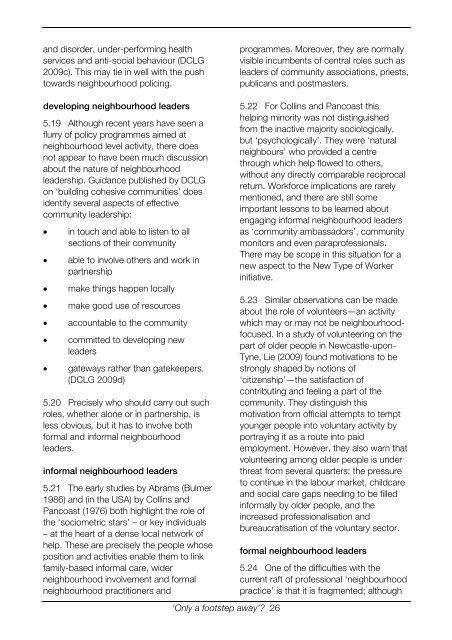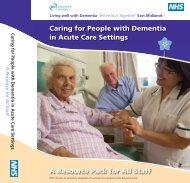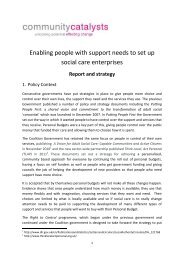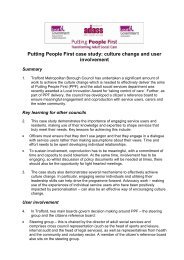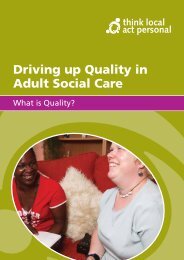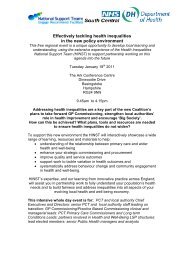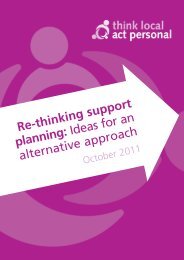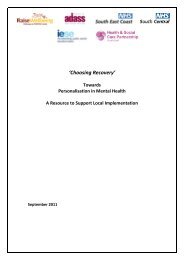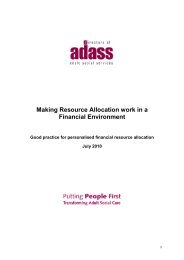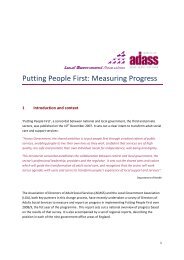'Only a footstep away' - Skills for Care - Think Local Act Personal
'Only a footstep away' - Skills for Care - Think Local Act Personal
'Only a footstep away' - Skills for Care - Think Local Act Personal
- No tags were found...
Create successful ePaper yourself
Turn your PDF publications into a flip-book with our unique Google optimized e-Paper software.
and disorder, under-per<strong>for</strong>ming healthservices and anti-social behaviour (DCLG2009c). This may tie in well with the pushtowards neighbourhood policing.programmes. Moreover, they are normallyvisible incumbents of central roles such asleaders of community associations, priests,publicans and postmasters.developing neighbourhood leaders5.19 Although recent years have seen aflurry of policy programmes aimed atneighbourhood level activity, there doesnot appear to have been much discussionabout the nature of neighbourhoodleadership. Guidance published by DCLGon ‘building cohesive communities’ doesidentify several aspects of effectivecommunity leadership:• in touch and able to listen to allsections of their community• able to involve others and work inpartnership• make things happen locally• make good use of resources• accountable to the community• committed to developing newleaders• gateways rather than gatekeepers.(DCLG 2009d)5.20 Precisely who should carry out suchroles, whether alone or in partnership, isless obvious, but it has to involve both<strong>for</strong>mal and in<strong>for</strong>mal neighbourhoodleaders.in<strong>for</strong>mal neighbourhood leaders5.21 The early studies by Abrams (Bulmer1986) and (in the USA) by Collins andPancoast (1976) both highlight the role ofthe ‘sociometric stars’ – or key individuals– at the heart of a dense local network ofhelp. These are precisely the people whoseposition and activities enable them to linkfamily-based in<strong>for</strong>mal care, widerneighbourhood involvement and <strong>for</strong>malneighbourhood practitioners and‘Only a <strong>footstep</strong> away’? 265.22 For Collins and Pancoast thishelping minority was not distinguishedfrom the inactive majority sociologically,but ‘psychologically’. They were ‘naturalneighbours’ who provided a centrethrough which help flowed to others,without any directly comparable reciprocalreturn. Work<strong>for</strong>ce implications are rarelymentioned, and there are still someimportant lessons to be learned aboutengaging in<strong>for</strong>mal neighbourhood leadersas ‘community ambassadors’, communitymonitors and even paraprofessionals.There may be scope in this situation <strong>for</strong> anew aspect to the New Type of Workerinitiative.5.23 Similar observations can be madeabout the role of volunteers—an activitywhich may or may not be neighbourhoodfocused.In a study of volunteering on thepart of older people in Newcastle-upon-Tyne, Lie (2009) found motivations to bestrongly shaped by notions of‘citizenship’—the satisfaction ofcontributing and feeling a part of thecommunity. They distinguish thismotivation from official attempts to temptyounger people into voluntary activity byportraying it as a route into paidemployment. However, they also warn thatvolunteering among older people is underthreat from several quarters: the pressureto continue in the labour market, childcareand social care gaps needing to be filledin<strong>for</strong>mally by older people, and theincreased professionalisation andbureaucratisation of the voluntary sector.<strong>for</strong>mal neighbourhood leaders5.24 One of the difficulties with thecurrent raft of professional ‘neighbourhoodpractice’ is that it is fragmented; although


